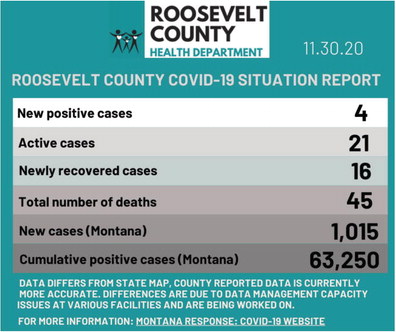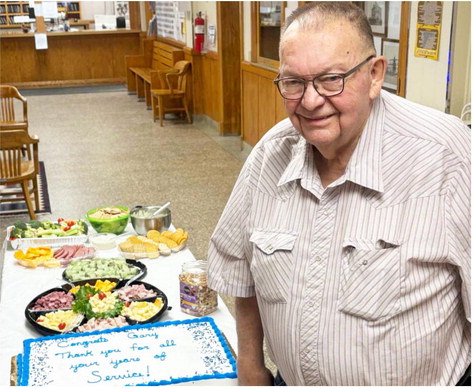County Reports 40 Active Cases, New School Liaison Works On COVID Response


A newly appointed school liaison, Lois Tufton, has started to provide regular reports to all Roosevelt County schools to bolster communication with and support for school-based COVID-19 response. Currently, many schools are experiencing increased rates of drop-outs, absenteeism and class failure. This alarming trend, while not unique to the area, is being addressed by each school to the fullest extent possible. The education, health and well-being of students remain of the utmost priority.
During the Roosevelt County COVID-19 Unified Command (task force) meeting on Wednesday, Nov. 25, updates were provided by the Fort Peck Tribes, Roosevelt County commissioners, Indian Health Service, Roosevelt Medical Center, John Hopkins, Roosevelt County Health Department and school superintendents.
The local task force congratulated Kaci Wallette and Dan Schmidt for appointments to the newly established State COVID-19 Task Force, which had its first meeting last week.
IHS and RMC continue to hold drive-through testing. RCHD is going to supply local medical facilities and schools with temporal thermometers and pulse oximeters. A standup temporal thermometer will be installed at the courthouse.
The Centers for Disease Control and Prevention are currently working with IHS to improve their COVID-19 response while the team from John Hopkins continues to provide weekly data reports for the Tribes. According to these reports, testing is still insufficient and positively rates remain high across the county and Fort Peck Reservation.
Two mass testing days, in conjunction with the Montana Disaster and Emergency Services, will occur on Dec. 11-12 from 9 a.m. to 6 p.m. at the Wolf Point Casino and the Poplar Cultural Center. These testing events are open to anyone interested in getting tested.
COVID-19 testing continues to be available from your health care provider as well at both IHS locations. If you have questions about COVID-19, email: covid-19taskforce@rooseveltcounty. For more information, visit the RCHD Facebook page or covid19.mt.gov.
Recent COVID figures for the county include four new cases and 40 active cases on Nov. 23, two new cases and 38 active cases on Nov. 24, five new cases and 40 active on Nov. 25, six new cases and 36 active on Nov. 26, and 13 new cases and 49 active on Nov. 27, Area health officials are stressing that flu shots are more important this year than ever because the COVID-19 pandemic. In order to keep the community safe, health officials offer advice and information on these two infections are related.
COVID-19 and the flu are each highly contagious respiratory infections, but have some key differences. They are caused by different viruses. COVID-19 is more infectious, and there is a vaccine to prevent the flu. There are some symptom similarities between the two, which may make it difficult to determine which illness you have if you are experiencing symptoms such as fever, fatigue, cough, difficulty breathing, sore throat, runny or stuffy nose, body aches, headache, vomiting and diarrhea. Flu can be a more mild illness than COVID-19, and COVID-19 symptoms also can include loss of taste or smell. It may be necessary to receive testing to determine which illness you are experiencing.
To get a flu shot, make an appointment with the Roosevelt County Health Department or make an appointment with your primary care provider.
Flu shots are available at the following locations: Roosevelt County Health Department, Chief Redstone IHS Clinic in Wolf Point, Verne E. Gibbs IHS Clinic in Poplar, Listerud Rural Health Clinic in Wolf Point, Riverside Clinic in Poplar and Roosevelt Medical Clinic in Culbertson.
Vaccines are covered by health insurance, Medicaid and Medicare. If you don’t have health insurance, call the health department for assistance at 653-6223.
The Fort Peck Tribes have announced that applications are now available for the third round of CARES Act relief payments. Go to fortpecktribes. org for an application. They are available online or you can pick one up in person. They will not be mailed out. The checks will not be sent out until Dec. 10.
As of Monday, Nov. 30, Roosevelt County had 40 current active cases of COVID-19. A total of 44 deaths have been reported. There were three new active cases listed reported.
In McCone County, there are six active cases. There have been 100 confirmed cases and 94 are listed as recovered.
As of Friday, Nov. 27, Valley County’s active count was 43, with 503 cases listed as recovered. Valley County reported six deaths due to COVID-19 and/or complications.
Daniels County had 25 active cases as of Tuesday, Dec. 1. The county has 94 recovered cases and 123 cumulative cases. Four deaths have occurred due to COVID-19 and/or complications. There is two cases currently hospitalized.
The Phillips County Health Department was reporting 45 active cases as of Friday, Nov. 27. Two hundred and thirty- six cases are listed as recovered. There are five active hospitalization. There have been six deaths.
For Richland County, there are 99 active cases and 754 recovered cases as of Tuesday, Dec. 1. Total deaths are nine. There have been 862 total cases in the county. More than 350 contacts are being monitored.
Statewide
According to Montana health officials, a total of 656,021 tests have been conducted statewide since the start of the pandemic.
The state’s total number of known cases now stands at 62,198 since the start of the pandemic.
Around the state, there are 16,031 active cases. There’s been a total of 2,622 hospitalizations with 477 active hospitalizations.
By Tuesday, Dec. 1, 681 deaths have been reported statewide. A total of 45,486 people are listed as recovered.
The governor’s directive requires face masking in any indoor space, open to the public, is mandatory for people ages 5 years and older. For children 2-4 years of age, face coverings are strongly encouraged. A drape may be used for babies. Restaurants, bars, breweries, distilleries and casinos are limited to 50 percent capacity and must close by 10 p.m. Public gatherings where social distancing isn’t possible or practiced will be limited to 25 people.
County sheriffs and other law enforcement across the state have said that the mask mandate is not enforceable and violations should not be called into 911.
Area Schools
Local health officials approved the Wolf Point School District to reopen four days a week (Plan A) starting Monday, Nov. 2. Classes began on that day for Wolf Point High School, Wolf Point Junior High School and Northside Elementary Schools. Classes resumed at Southside Elementary on Wednesday, Nov. 11.
The Frontier Elementary School started a new schedule for classes. On Monday, students in grades K, 1, 2, 3, 6 and 7 attend. On Tuesday, students in grades K, 1, 2, 4, 5 and 8 attend. On Wednesday, students in grades K, 1, 2, 3, 6 and 7 attend. On Thursday, students in grades K, 1, 2, 4, 5 and 8 attend. On Friday, students in grades K, 1, 2, 3, 4 attend. Afternoon dismissal time for all grades has returned to 3:30 p.m. Monday-Thursday and 2:30 p.m. on Friday.
The Frazer School returned to in-class instruction Oct. 5. Students are offered the optout option.
Brockton School had students return to classes on Monday, Oct. 19. There are a few students listed as opt-out.
Poplar High School students returned to classes on Monday, Nov. 2, with the option of staying remote. Students in middle school and elementary are still distance learning. The tentative plan is for middle school and elementary students to return to classes on Jan. 20, 2021.
Fort Peck Tribes
The Fort Peck Tribes moved to Phase 1 Tuesday, Sept. 29. Phase 1 puts non-essential employees and residents on the reservation under stay at home orders and limits gatherings to 10 people or fewer. All households are being asked to maintain 6 feet distance, wear masks and sanitize. COVID-19 & Mental Health
The COVID-19 pandemic and ensuing response have brought many changes to our lives. Across the world, reports are coming in on how this pandemic affects mental health. These effects include increased stress, fear, anxiety and worry. The World Health Organization and Centers for Disease Control and Prevention, the State of Montana, among many others, have begun providing guidance and materials on how to cope with the mental health effects of the COVID-19 pandemic. From healthcare workers to caregivers to children to individuals in isolation, COVID-19 is affecting everyone, including residents of Roosevelt County. Unhealthy coping mechanisms, such as increased tobacco or alcohol use, can put yourself and those around you at increased risk.
If you or a loved one are experiencing a mental health crisis, seek immediate help: Suicide Prevention Lifeline: 800-273-8255, the Crisis Text Line can be reached by texting “MT” to 741-741, Eastern Montana Mental Health Cen- ter Toll Free Crisis Phone Line: 800-597-6608, or call 911.If you or a loved one are experiencing a substance use issue, reach out to the following for help: SAMHSA’s National Helpline: 800-662-HELP (4357) and TTY 800-487-4889, Eastern Montana Community Mental Health Center 653-1872.
For more information, visit the RCHD Facebook page or covid19.mt.gov or the CDC’s Coping with Stress page, www.cdc.gov/coronavirus/ 2019-ncov/daily-life-coping/ managing-stress-anxiety. html.
Testing
COVID-19 testing continues to be available from your healthcare provider, as well as at both IHS locations.
Vaccine
On Nov. 9, Pfizer announced its COVID-19 vaccine is 90 percent effective in preventing infection. It was announced in July that the Trump administration entered into an agreement with Pfizer to own 100 million doses of the vaccine after it’s manufactured and receives approval or emergency use authorization from the FDA. This $1.95 billion agreement will help with production and nationwide delivery of the vaccine.
The Department of Public Health and Human Services this week announced that they have received the largest shipment of the 2009 H1N1 vaccine to date.
More than 37,000 doses of vaccine arrived in Montana this week, bringing the total number of doses the state has received to over 194,000. These doses have been distributed to county and tribal health departments for disbursement to clinical, hospital and private providers.
People now eligible for vaccination in Montana are: pregnant women, health care workers, all children and adults aged six months to 24 years and caregivers of children 6 months and younger and adults 25 to 64 years of age who have a chronic health condition that puts them at risk if they were infected with influenza.
CDC’s Advisory Committee on Immunization Practices (ACIP), a panel made up of medical and public health experts, made recommendations on who should receive the 2009 H1N1 vaccine. The ACIP considered several factors, including (1) current disease patterns, (2) populations most at-risk for severe illness, hospitalization and death, (3) how much vaccine is expected to be available and (4) the timing of vaccine availability.
“I really want to urge people in the target groups who haven’t done so to get the vaccine,” said DPHHS director Anna Whiting Sorrell. “I especially want to encourage parents to have their children vaccinated as H1N1 influenza has been a bigger threat to children and young adults than the adult population.”
With the spread of the 2009 H1N1 virus, the Department is interested in controlling outbreaks of influenza by educating people about healthy habits and preventing illness. Consequently, DPHHS has released a pair of public service announcements to promote influenza prevention and the importance of getting the H1N1 vaccine. Radio and television advertisements have been distributed across the state.
The department has also established a statewide hotline that directs callers to their local health department for information about vaccination clinics. A caller can dial the number 1-877-701-8555 and reach a recorded message from their local health department regarding information about local vaccine availability. People can also learn about vaccination clinics being offered statewide by going to the DPHHS Web site at www.dphhs.mt.gov.
These tools are designed to serve as a supplement to the hard work already occurring at the local level. “Local health departments have really gone the extra mile over the past several months by holding countless vaccination clinics all across Montana,” DPHHS Communicable Disease Control and Prevention Bureau Chief Jim Murphy said. “Clinics are being held now, and there is no cost for the H1N1 vaccine. I encourage those who haven’t done so to take advantage of this opportunity.”
For more information call the DPHHS Immunization Section at 406-444-5580.



